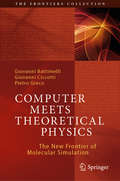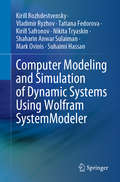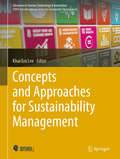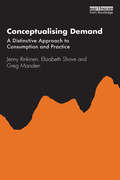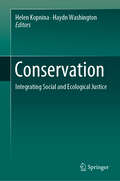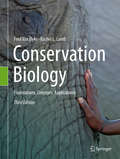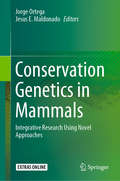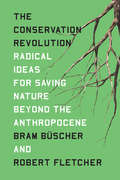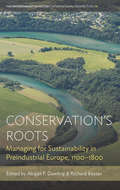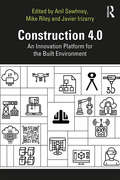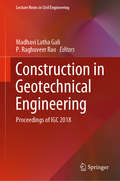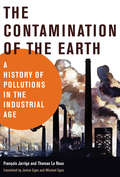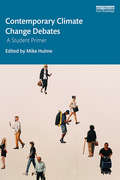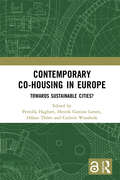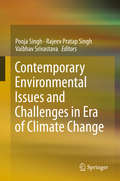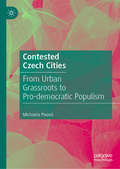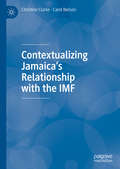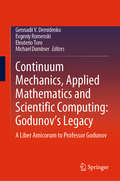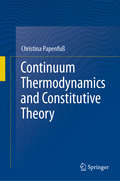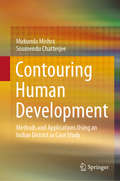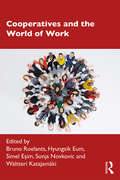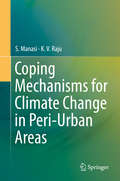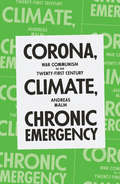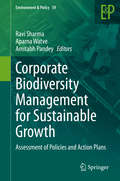- Table View
- List View
Computer Meets Theoretical Physics: The New Frontier of Molecular Simulation (The Frontiers Collection)
by Giovanni Battimelli Giovanni Ciccotti Pietro GrecoThis book provides a vivid account of the early history of molecular simulation, a new frontier for our understanding of matter that was opened when the demands of theoretical physicists were met by the availability of the modern computers. Since their inception, electronic computers have enormously increased their performance, thus making possible the unprecedented technological revolution that characterizes our present times. This obvious technological advancement has brought with it a silent scientific revolution in the practice of theoretical physics. In particular, in the physics of matter it has opened up a direct route from the microscopic physical laws to observable phenomena. One can now study the time evolution of systems composed of millions of molecules, and simulate the behaviour of macroscopic materials and actually predict their properties. Molecular simulation has provided a new theoretical and conceptual tool that physicists could only dream of when the foundations of statistical mechanics were laid. Molecular simulation has undergone impressive development, both in the size of the scientific community involved and in the range and scope of its applications. It has become the ubiquitous workhorse for investigating the nature of complex condensed matter systems in physics, chemistry, materials and the life sciences. Yet these developments remain largely unknown outside the inner circles of practitioners, and they have so far never been described for a wider public. The main objective of this book is therefore to offer a reasonably comprehensive reconstruction of the early history of molecular simulation addressed to an audience of both scientists and interested non-scientists, describing the scientific and personal trajectories of the main protagonists and discussing the deep conceptual innovations that their work produced.
Computer Modeling and Simulation of Dynamic Systems Using Wolfram SystemModeler
by Shaharin Anwar Sulaiman Kirill Rozhdestvensky Vladimir Ryzhov Tatiana Fedorova Kirill Safronov Nikita Tryaskin Mark Ovinis Suhaimi HassanThis book briefly discusses the main provisions of the theory of modeling. It also describes in detail the methodology for constructing computer models of dynamic systems using the Wolfram visual modeling environment, SystemModeler, and provides illustrative examples of solving problems of mechanics and hydraulics. Intended for students and professionals in the field, the book also serves as a supplement to university courses in modeling and simulation of dynamic systems.
Concepts and Approaches for Sustainability Management (Advances in Science, Technology & Innovation)
by Khai Ern LeeWith the introduction of the 2030 Agenda for Sustainable Development by the United Nations General Assembly in 25 September 2015, UN agencies, member states and stakeholders have begun to focus on the adoption and implementation of these strategies in realization of 17 Sustainable Development Goals. To work toward sustainability, strategic measures to encourage stakeholders to contribute to the goals of the 2030 agenda are needed. In recognition of these efforts, this book is produced to compile research concepts and approaches for the area of sustainability management of industry, technology development, community, education and the environment. The objective of this book is to deliberate concepts and approaches of sustainability management taking place in Malaysia whereby case studies will be revealed to provide way forward of sustainability management toward achieving sustainable development. The insights provided can be applied to advanced and developing countries by sustainable development practitioners, encompassing government agencies, academia, industries, NGOs and community, who would like to adopt the concept of approach of sustainability into their area of management.
Conceptualising Demand: A Distinctive Approach to Consumption and Practice
by Jenny Rinkinen Elizabeth Shove Greg MarsdenThis book addresses fundamental questions about the very idea of demand: how is it constituted, how does it change and how might it be steered? Conceptualising Demand focuses on five core propositions: that demand is derived from social practices; that it is made and not simply met; that it is materially embedded and temporally unfolding; and that it is modulated through many forms of policy and governance. In working through these claims, the book weaves concepts from the sociology of consumption, science and technology studies, policy analyses and social theories of practice together with empirical cases and new research into such topics as the rise of refrigerated foods, the emergence of online shopping and the transformation of energy demanding services. This innovative book takes a fresh look at the very idea of demand, a concept that is often taken for granted, but that is vital for scholars and students of energy, mobility, climate change and consumption, and anyone interested in the subject.
Condor Comeback (Scientists in the Field Series)
by Sy MontgomerySibert Medalist, National Book Award Honoree, and New York Times best-selling author Sy Montgomery turns her formidable talents to the story of California condors and the scientists who have fought against their extinction in this installment in the award-winning Scientists in the Field series. In April of 1987 the last wild California condor was captured and taken to live in captivity like the other twenty-six remaining birds of its kind. Many thought that the days were over of of this remarkable, distinguished bird that had roamed the skies of North and Central American for thousands of years. Sy Montgomery employs her skill for on-the-ground reporting, shrewd observation, and stunning narrative prose to detail the efforts of scientists, volunteers, and everyday citizens to get California condors back in the wild. In particular, Montgomery profiles employees at the Santa Barbara Zoo who have worked tirelessly to raise abandoned chicks, nurse sick birds back to health, and conduct research that can support legislation to ban what is probably the largest threat to the existence of the wild condor: lead bullets. In turns affectionate and frustrated, hopeful and heartbreaking, Montgomery&’s powerful prose does justice to these ancient, sociable, and elegant creatures. Complete with world-class, full-color photography and helpful sidebars that provide details such as the history of the bird&’s fight back from extinction, the dangers of lead poisoning, and the relationship of condors to the Chumash nation, Condor Comeback is an inspiring story of groundbreaking science, perseverance, and cooperation.
Conservation: Integrating Social and Ecological Justice (Routledge Explorations In Environmental Studies)
by Helen Kopnina Haydn WashingtonThis book provides keys to decrypt current political debates on the environment in light of the theories that support them, and provides tools to better understand and manage environmental conflicts and promote environmentally friendly behaviour. As we work towards global sustainability at a time when efforts to conserve biodiversity and combat climate change correspond with land grabs by large corporations, food insecurity, and human displacement. While we seek to reconcile more-than-human relations and responsibilities in the Anthropocene, we also struggle to accommodate social justice and the increasingly global desire for economic development. These and other challenges fundamentally alter the way social scientists relate to communities and the environment. This book takes as its point of departure today’s pressing environmental challenges, particularly the loss of biodiversity, and the role of communities in protected areas conservation. In its chapters, the authors discuss areas of tension between local livelihoods and international conservation efforts, between local communities and wildlife, and finally between traditional ways of living and ‘modernity’. The central premise of this book is while these tensions cannot be easily resolved they can be better understood by considering both social and ecological effects, in equal measure. While environmental problems cannot be seen as purely ecological because they always involve people, who bring to the environmental table their different assumptions about nature and culture, so are social problems connected to environmental constraints. While nonhumans cannot verbally bring anything to this negotiating table, aside from vast material benefits that society relies on, the distinct perspective of this book is that there is a need to consider the role of nonhumans as equally important stakeholders – albeit without a voice. This book develops an argument that human-environmental relationships are set within ecological reality and ecological ethics and rather than being mutually constitutive processes, humans have obligate dependence on nature, not vice versa. This would enable an ethical position encompassing the needs of other species and giving simultaneous (without one being subordinated to another) consideration to justice for humans and non-humans alike. The book is accessible to both social scientists and conservation specialists, and intends to contribute to strengthening interdisciplinary collaborations in the field of conservation.
Conservation Biology: Foundations, Concepts, Applications
by Rachel L. Lamb Fred Van DykeThis book provides a thorough, up-to-date examination of conservation biology and the many supporting disciplines that comprise conservation science. In this, the Third Edition of the highly successful Conservation Biology: Foundations, Concepts, Applications, the authors address their interdisciplinary topic as it must now be practiced and perceived in the modern world. Beginning with a concise review of the history of conservation, the authors go on to explore the interplay of conservation with genetics, demography, habitat and landscape, aquatic environments, and ecosystem management, and the relationship of all these disciplines to ethics, economics, law, and policy. An entirely new chapter, The Anthropocene: Conservation in a Human-Dominated Nature, breaks new ground in its exploration of how conservation can be practiced in anthropogenic biomes, novel ecosystems, and urban habitats. The Third Edition includes the popular Points of Engagement discussion questions used in earlier editions, and adds a new feature: Information Boxes, which briefly recap specific case histories described in the text. A concluding chapter offers insight into how to become a conservation professional, in both traditional and non-traditional roles.The authors, Fred Van Dyke and Rachel Lamb, draw on their expertise as field biologists, wildlife managers, consultants to government and industry, and scholars of environmental law, policy, and advocacy, as well as their many years of effective teaching experience. Informed by practical knowledge and acquired skills, the authors have created a work of exceptional clarity and readability which encompasses both systemic foundations as well as contemporary developments in the field. Conservation Biology: Foundations, Concepts, Applications will be of invaluable benefit to undergraduate and graduate students, as well as to working conservation scientists and managers.This is an amazing resource for students, faculty, and practitioners both new and experienced to the field. Diane Debinski, PhD Unexcelled wisdom for living at home on Wonderland Earth, the planet with promise, destined for abundant life. Holmes Rolston, PhDVan Dyke and Lamb have maintained the original text’s emphasis on connecting classical ecological and environmental work with updated modern applications and lucid examples. But more importantly, the third edition contains much new material on the human side of conservation, including expanded treatments of policy, economics, and climate change. Tim Van Deelen, PhD Fred Van Dyke and Rachel Lamb break new ground in both the breadth and depth of their review and analysis of this crucially important and rapidly changing field. Any student or other reader wishing to have a comprehensive overview and understanding of the complexities of conservation biology need look no further – this book is your starting point! Simon N. Stuart, PhDAnyone who teaches, talks or writes and works on Conservation Biology, needs this latest edition of Conservation Biology (Foundations, Concepts, Applications, 3rd edition) by Fred Van Dyke and Rachel L. Lamb. This will be useful to both beginners and experts as well. The authors included almost all important issues in relation to conservation biology. This is really an outstanding book. Bidhan Chandra Das, Professor, Ecology Branch, Department of Zoology, University of Rajshahi, Bangladesh
Conservation Genetics in Mammals: Integrative Research Using Novel Approaches
by Jorge Ortega Jesus E. MaldonadoThis book focuses on the use of molecular tools to study small populations of rare and endangered mammals, and presents case studies that apply an evolutionary framework to address innovative questions in the emerging field of mammalian conservation genomics using a highly diverse set of novel molecular tools. Novel and more precise molecular technologies now allow experts in the field of mammology to interpret data in a more contextual and empirical fashion and to better describe the evolutionary and ecological processes that are responsible for the patterns they observe. The book also demonstrates how recent advances in genetic/genomic technologies have been applied to assess the impact of environmental/anthropogenic changes on the health of small populations of mammals. It examines a range of issues in the field of mammalian conservation genomics, such as the role that the genetic diversity of the immune system plays in disease protection and local adaptation; the use of noninvasive techniques and genomic banks as a resource for monitoring and restoring populations; the structuring of population by physical barriers; and genetic diversity. Further, by integrating research from a variety of areas – including population genetics, molecular ecology, systematics, and evolutionary and conservation biology – it enables readers to gain a deeper understanding of the conservation biology of mammals that are at increasing risk of extinction at local, regional and global scales. As such, it offers a unique resource for a broad readership interested in the conservation biology of mammals and conservation management strategies to better preserve biodiversity.
The Conservation Revolution: Radical Ideas for Saving Nature Beyond the Anthropocene
by Bram Buscher Robert FletcherA post-capitalist manifesto for conservationConservation needs a revolution. This is the only way it can contribute to the drastic transformations needed to come to a truly sustainable model of development. The good news is that conservation is ready for revolution. Heated debates about the rise of the Anthropocene and the current &‘sixth extinction&’ crisis demonstrate an urgent need and desire to move beyond mainstream approaches. Yet the conservation community is deeply divided over where to go from here. Some want to place &‘half earth&’ into protected areas. Others want to move away from parks to focus on unexpected and &‘new&’ natures. Many believe conservation requires full integration into capitalist production processes. Building a razor-sharp critique of current conservation proposals and their contradictions, Büscher and Fletcher argue that the Anthropocene challenge demands something bigger, better and bolder. Something truly revolutionary. They propose convivial conservation as the way forward. This approach goes beyond protected areas and faith in markets to incorporate the needs of humans and nonhumans within integrated and just landscapes. Theoretically astute and practically relevant, The Conservation Revolution offers a manifesto for conservation in the twenty-first century—a clarion call that cannot be ignored.
Conservation’s Roots: Managing for Sustainability in Preindustrial Europe, 1100–1800 (Environment in History: International Perspectives #19)
by Abigail P. Dowling Richard KeyserThe ideas and practices that comprise “conservation” are often assumed to have arisen within the last two centuries. However, while conservation today has been undeniably entwined with processes of modernity, its historical roots run much deeper. Considering a variety of preindustrial European settings, this book assembles case studies from the medieval and early modern eras to demonstrate that practices like those advocated by modern conservationists were far more widespread and intentional than is widely acknowledged. As the first book-length treatment of the subject, Conservation’s Roots provides broad social, historical, and environmental context for the emergence of the nineteenth-century conservation movement.
Construction 4.0: An Innovation Platform for the Built Environment
by Anil Sawhney Michael Riley Javier IrizarryModelled on the concept of Industry 4.0, the idea of Construction 4.0 is based on a confluence of trends and technologies that promise to reshape the way built environment assets are designed, constructed, and operated. With the pervasive use of Building Information Modelling (BIM), lean principles, digital technologies, and offsite construction, the industry is at the cusp of this transformation. The critical challenge is the fragmented state of teaching, research, and professional practice in the built environment sector. This handbook aims to overcome this fragmentation by describing Construction 4.0 in the context of its current state, emerging trends and technologies, and the people and process issues that surround the coming transformation. Construction 4.0 is a framework that is a confluence and convergence of the following broad themes discussed in this book: Industrial production (prefabrication, 3D printing and assembly, offsite manufacture) Cyber-physical systems (actuators, sensors, IoT, robots, cobots, drones) Digital and computing technologies (BIM, video and laser scanning, AI and cloud computing, big data and data analytics, reality capture, Blockchain, simulation, augmented reality, data standards and interoperability, and vertical and horizontal integration) The aim of this handbook is to describe the Construction 4.0 framework and consequently highlight the resultant processes and practices that allow us to plan, design, deliver, and operate built environment assets more effectively and efficiently by focusing on the physical-to-digital transformation and then digital-to-physical transformation. This book is essential reading for all built environment and AEC stakeholders who need to get to grips with the technological transformations currently shaping their industry, research, and teaching.
Construction in Geotechnical Engineering: Proceedings of IGC 2018 (Lecture Notes in Civil Engineering #84)
by Madhavi Latha Gali P. Raghuveer RaoThis volume comprises select papers presented during the Indian Geotechnical Conference 2018. This volume discusses construction challenges and issues in geotechnical engineering. The contents cover foundation design and analysis, issues related to geotechnical structures, including dams, retaining walls, embankments and pavements, and rock mechanics and construction in rocks and rocky environments. Many of the papers discuss live case studies related to important geotechnical engineering projects worldwide, providing useful insights into the realistic designs and constructions. This volume will be of interest to students, researchers and practitioners alike.
The Contamination of the Earth: A History of Pollutions in the Industrial Age (History for a Sustainable Future)
by Francois Jarrige Thomas Le RouxThe trajectories of pollution in global capitalism, from the toxic waste of early tanneries to the poisonous effects of pesticides in the twentieth century.Through the centuries, the march of economic progress has been accompanied by the spread of industrial pollution. As our capacities for production and our aptitude for consumption have increased, so have their byproducts—chemical contamination from fertilizers and pesticides, diesel emissions, oil spills, a vast “plastic continent” found floating in the ocean. The Contamination of the Earth offers a social and political history of industrial pollution, mapping its trajectories over three centuries, from the toxic wastes of early tanneries to the fossil fuel energy regime of the twentieth century.The authors describe how, from 1750 onward, in contrast to the early modern period, polluted water and air came to be seen as inevitable side effects of industrialization, which was universally regarded as beneficial. By the nineteenth century, pollutants became constituent elements of modernity. The authors trace the evolution of these various pollutions, and describe the ways in which they were simultaneously denounced and permitted. The twentieth century saw new and massive scales of pollution: chemicals that resisted biodegradation, including napalm and other defoliants used as weapons of war; the ascendancy of oil; and a lifestyle defined by consumption. In the 1970s, pollution became a political issue, but efforts—local, national, and global—to regulate it often fell short. Viewing the history of pollution though a political lens, the authors also offer lessons for the future of the industrial world.
Contemporary Climate Change Debates: A Student Primer
by Mike HulmeContemporary Climate Change Debates is an innovative new textbook which tackles some of the difficult questions raised by climate change. For the complex policy challenges surrounding climate migration, adaptation and resilience, structured debates become effective learning devices for students. This book is organised around 15 important questions, and is split into four parts: What do we need to know? What should we do? On what grounds should we base our actions? Who should be the agents of change? Each debate is addressed by pairs of one or two leading or emerging academics who present opposing viewpoints. Through this format the book is designed to introduce students of climate change to different arguments prompted by these questions, and also provides a unique opportunity for them to engage in critical thinking and debate amongst themselves. Each chapter concludes with suggestions for further reading and with discussion questions for use in student classes. Drawing upon the sciences, social sciences and humanities to debate these ethical, cultural, legal, social, economic, technological and political roadblocks, Contemporary Debates on Climate Change is essential reading for all students of climate change, as well as those studying environmental policy and politics and sustainable development more broadly.
Contemporary Co-housing in Europe (Open Access): Towards Sustainable Cities?
by Hakan Thorn Henrik Gutzon Larsen Cathrin Wasshede Pernilla HagbertThis book investigates co-housing as an alternative housing form in relation to sustainable urban development. Co-housing is often lauded as a more sustainable way of living. The primary aim of this book is to critically explore co-housing in the context of wider social, economic, political and environmental developments. This volume fills a gap in the literature by contextualising co-housing and related housing forms. With focus on Denmark, Sweden, Hamburg and Barcelona, the book presents general analyses of co-housing in these contexts and provides specific discussions of co-housing in relation to local government, urban activism, family life, spatial logics and socio-ecology. This book will be of interest to students and researchers in a broad range of social-scientific fields concerned with housing, urban development and sustainability, as well as to planners, decision-makers and activists.
Contemporary Environmental Issues and Challenges in Era of Climate Change
by Pooja Singh Rajeev Pratap Singh Vaibhav SrivastavaOver the last few decades, unprecedented global population growth has led to increased demand for food and shelter. At the same time, extraction of natural resources beyond the Earth’s resilience capacity has had a devastating effect on ecosystems and environmental health. Furthermore, climate change is having a significant impact in a number of areas, including the global hydrological cycle, ecosystem functioning, coastal vulnerability, forest ecology, food security, and agricultural sustainability. According to the Intergovernmental Panel on Climate Change (IPCC), only immediate and sustained action will prevent climate change causing irreversible and potentially catastrophic damage to our environment. This book presents various scientific views and concepts, research, reviews, and case studies on contemporary environmental issues in changing climate scenarios and highlights different adaptation measures. Increasing awareness of modern-day patterns of climate change, it addresses questions often raised by environmental scientists, researchers, policymakers and general readers.
Contested Czech Cities: From Urban Grassroots to Pro-democratic Populism
by Michaela PixováThis book focuses on urban grassroots movements in post-socialist Czechia and their struggle against unprofessional and nondemocratic urban processes in their cities. It shows that in the context of neoliberal urban restructuring, weakly consolidated democracy, and corporate capture of the local state, urban activists often resort to entering electoral competition as the only efficient way of improving the situation in their cities. The book is based on four case studies from different Czech cities, narrating stories of activists struggling against a controversial flood protection project, the demolition of public buildings, an unhealthy land-use plan, arrogant development, and overpriced city halls. It offers valuable insight into the obstacles created by institutionalized forms of power abuse which urban activists must deal with and discusses the pro-democratic potential of urban grassroot movements’ efforts to overcome their limited ability to influence political processes via standard means of civic engagement and protest activities.
Contextualizing Jamaica’s Relationship with the IMF
by Christine Clarke Carol NelsonThis ambitious book provides a comprehensive quantitative and qualitative assessment of Jamaica’s ties to the International Monetary Fund, focusing on Jamaica’s historical relationship with the IMF and reflecting on the domestic and international discourse surrounding the evolution of this relationship. Notably, this volume presents a critical analysis of Jamaica’s first engagement with and departure from the IMF and interrogates the political economy of the period. Jamaica’s economic experiences are assessed in the context of major global events, including the food price crises of 2007 and the global economic crises of 2008 and 2009. This book also looks at policy implications, and its well-researched analysis will be of great value to practitioners and policymakers as well as academics.
Continuum Mechanics, Applied Mathematics and Scientific Computing: A Liber Amicorum to Professor Godunov (Advanced Structured Materials Ser. #107)
by Gennadii V. Demidenko Evgeniy Romenski Eleuterio Toro Michael DumbserThis book is a liber amicorum to Professor Sergei Konstantinovich Godunov and gathers contributions by renowned scientists in honor of his 90th birthday. The contributions address those fields that Professor Godunov is most famous for: differential and difference equations, partial differential equations, equations of mathematical physics, mathematical modeling, difference schemes, advanced computational methods for hyperbolic equations, computational methods for linear algebra, and mathematical problems in continuum mechanics.
Continuum Thermodynamics and Constitutive Theory
by Christina PapenfußThis book presents different thermodynamic approaches in the area of constitutive theory: thermodynamics of irreversible processes, rational thermodynamics, and extended thermodynamics. These different approaches are analyzed with respect to their presuppositions, as well as to their results, and each method is applied to several important examples. In many cases these examples are archetypes for numerous technologically important materials; i.e. complex materials having an internal structure. Some of the examples dealt with in this book are liquid crystals, colloid suspensions, ans fiber suspensions. The book well serves students and researchers who have basic knowledge in continuum mechanics and thermodynamics. It provides a systematic overview of the vast field of thermodynamic constitutive theory, beginning from a historical perspective and concluding with outstanding questions in recent research.
Contouring Human Development: Methods and Applications Using an Indian District as Case Study
by Soumendu Chatterjee Mukunda MishraThis book acquaints readers with a range of techniques to help them effectively identify, record, map, analyze and report on patterns in various dimensions of human development (HD) with spatial scales down to the village level. It is impossible to capture HD at the local and global scale with only a single index, because differences in HD at the international scale are caused by ‘general’ factors, whereas local-scale differences are influenced by ‘specific’ factors. This book offers a variety of methods for scientifically mapping HD at any spatial scale. It covers how to rationally select variables; how to test the models; how to validate the results, and how to analyze them. For this purpose, it employs a case study on an Indian district. The socio-economic factors regulating the patterns of HD are now more complex than they were only a few decades ago, making it essential to incorporate newer models in order to successfully ‘replicate’ the real-world situation. Accordingly, the book offers essential methodological tools & techniques for mapping HD. It sheds new light on a handful of statistical multivariate analysis and machine learning algorithms that are rarely used in the social sciences when dealing with HD, yet have sound mathematical and statistical bases. These techniques can be successfully used for predictive analysis in the earth & natural sciences, decision sciences and management disciplines, and are equally effective in terms of capturing, predicting and projecting the composite HD ‘landscape.’ This book will especially benefit two groups of readers: firstly, HD practitioners who want to find out ‘why some areas are doing better than others’ by exploring the complex interactions of spatially linked variables with different HD parameters. And secondly, practitioners in other branches of the social sciences who are not concerned with HD but are looking for ‘hands-on training’ with techniques they can apply in their respective field of spatial investigations.
Cooperatives and the World of Work
by Bruno Roelants Hyungsik Eum Simel Esim Sonja Novkovic Waltteri KatajamäkiAs the world of work and jobs is more uncertain than ever because of various trends impacting it, including the rise of robotics and the gig economy, Cooperatives and the World of Work furthers the debate on the future of work, sustainable development, and the social and solidarity economy of which cooperatives are a fundamental component. Throughout the book, the authors, who are experts in their respective fields, do not limit themselves to praising the advantages of the cooperative model. Rather, they challenge the narrow understanding of cooperatives as a mere business model and raise debate on the more fundamental role that cooperatives play in responding to social changes and in changing society itself. The book is unique in tracing the historical connection between cooperatives and the world of work since the end of the First World War and the recent shifts and restructuring in enterprise and the workplace. It presents a redefinition of the very concept of work, focusing on organizational innovation. This book is published in recognition of 100 years of the International Labour Organization, and gathers together research from leading experts who were brought together at an event co-hosted by the International Co-operative Alliance (ICA) and the International Labour Organization (ILO).
Coping Mechanisms for Climate Change in Peri-Urban Areas
by S. Manasi K. V. RajuThis book discusses the dynamics and resource management qualities of the peri-urban interface to address climate change consequences, focusing on the peri-urban region of the global city of Bengalaru. In 5 chapters, the authors document the unique challenges experienced in peri-urban areas, including soil-water vegetation dynamics, local and regional impacts on water bodies (surface and groundwater), food production issues, and the inhibited adaptive capacity of local communities. The book also provides knowledge on implementations of environmental management by local institutions, government interventions that have acted as catalysts in promoting community based adaptation strategies, and the physical, social and economic aspects of rural-urban dynamics. The book not only adds to the scarce existing literature on peri-urban contexts, but also addresses the role of culture in protecting ecological landscapes and how traditions play an important role in coping with climate change. Furthermore, the authors expand on these climate change coping mechanisms in peri-urban areas, taking into account local cultural factors and interesting governance interventions in the context of health. The book will be of interest to planners, policy makers, and students and researchers engaged in rural-urban dynamics and climate change adaptation.
Corona, Climate, Chronic Emergency: War Communism in the Twenty-First Century
by Andreas MalmWhat does the COVID 19 tell us about the climate breakdown, and what should we do about it?The economic and social impact of the coronavirus pandemic has been unprecedented. Governments have spoken of being at war and find themselves forced to seek new powers in order to maintain social order and prevent the spread of the virus. This is often exercised with the notion that we will return to normal as soon as we can. What if that is not possible? Secondly, if the state can mobilize itself in the face of an invisible foe like this pandemic, it should also be able to confront visible dangers such as climate destruction with equal force. In Corona, Climate, Chronic Emergency, leading environmental thinker, Andreas Malm demands that this war-footing state should be applied on a permanent basis to the ongoing climate front line. He offers proposals on how the climate movement should use this present emergency to make that case. There can be no excuse for inaction any longer.
Corporate Biodiversity Management for Sustainable Growth: Assessment of Policies and Action Plans (Environment & Policy #59)
by Ravi Sharma Aparna Watve Amitabh PandeyThis book aims to cover the multitude of corporate approaches towards mainstreaming biodiversity conservation and ecological management in policies and action plans, and explores the roles of these efforts in achieving national and global targets for the Sustainable Development Goals (SDGs). The book addresses various aspects of corporate actions such as corporate environmental responsibility, green businesses, market-based approaches to biodiversity conservation, and biodiversity trade-offs, and includes concept papers, reviews, and case studies presenting qualitative and quantitative research. Additionally, the text compares and assesses examples of positive and negative impacts of corporate involvement in biodiversity conservation in developed and developing countries to identify innovative approaches, and the best practices and models that can be replicated in diverse environmental conditions. The studies included in the book will help those working in the field of corporate involvement in biodiversity conservation, and outline the strengths and weaknesses of the approaches which will be useful for designing new environmental management action plans in the face of climate change. The book will also be of great value to researchers, academicians, policy makers, civil society groups, policy think tanks, and conservation managers.
